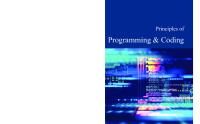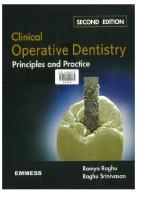Defensive & Offensive Principles [PDF]
NUNO COELHO – DIRECTOR OF FOOTBALL 1 Pressure means to deny an opponent both the time and space in which to play t
43 1 716KB
Papiere empfehlen
![Defensive & Offensive Principles [PDF]](https://vdoc.tips/img/200x200/defensive-amp-offensive-principles.jpg)
- Author / Uploaded
- Sam Gill
Datei wird geladen, bitte warten...
Zitiervorschau
NUNO COELHO – DIRECTOR OF FOOTBALL
1
Pressure means to deny an opponent both the time and space in which to play the ball and to prevent him from passing or dribbling the ball forward.
As soon as the ball is lost, a player from the team that has just lost possession must apply immediate pressure.
The purpose of immediate pressure on the ball Is, firstly, to try to regain possession. If It's not possible to regain possession, then the next objective of immediate pressure is to prevent opponents from playing the ball forward and mount a counterattack. By delaying the opponent's attack, immediate pressure allows teammates to recover goal-side of the ball and get organized.
NUNO COELHO – DIRECTOR OF FOOTBALL
2
Cover in defense refers to the help given to the pressuring player by a teammate or teammates positioned dose behind him. If the pressuring player is beat by a dribble, the covering player can apply Immediate pressure. Hence, cover provides the extra safety against penetration and allows the beaten defender to recover and the defense to reorganize.
Of prime importance are both the distance and angle of the covering player. He should be close enough so that he can apply immediate pressure If the challenging player is beaten. However, he should not be so close that a quick attacker can beat both players by playing the ball past both of them and accelerating.
NUNO COELHO – DIRECTOR OF FOOTBALL
3
Balance addresses the defensive needs in the areas away from the ball. Whereas pressure and cover are narrowly focused on the ball, balance takes care of the rest of the field. Defenders who are far from the ball and on the other side of the field are the ones who must provide balance.
A team with good balance has players who are positioned to apply quick pressure on the ball if It's switched to the other side of the field.
NUNO COELHO – DIRECTOR OF FOOTBALL
4
As soon as possession of the ball is lost, and as one player is applying immediate pressure on the ball, all the other players must fall back and recover to a position both goal-side of the ball and goal-side of the opponents.
The objective of these recovery runs is to get the whole team between the ball and the goal (goal-side of the ball) and create 'numbers up' around the ball as well as in the back.
Recovery runs usually fall under one of three general purposes: 1) to apply pressure on the ball; 2) to get goal-side of an opponent in order to mark him; or 3) to get goal-side of the ball and cover space behind teammates.
NUNO COELHO – DIRECTOR OF FOOTBALL
5
The whole team squeezes together both vertically and laterally in order to reduce the spaces between them, cover for each other, and create numbers up around the ball.
Defenders must push up as their team is going forward to reduce the gap between them and their own midfield. Likewise, the space between the midfield and the forwards can be reduced, either by the forwards retreating when the ball is lost or by the midfielders pushing up behind the forwards. As soon as the ball is lost, the wide players on the far side of the field must pinch inside In order to reduce the spaces in midfield.
Keeper's role has evolved to play as sweeperkeeper.
6
The objective of the game is to score goals, penetration is not just about going forward, but also getting the ball into areas behind opponents. It means attacking the spaces behind opposing defenders to create goal chances. Penetration can be accomplished in many ways: An individual dribbling past a defender, a combination play between two players such as a wall pass, a crossover or an overlap, or a long pass Into space behind opponents.
For penetration to occur, the two most important elements are:
1) players must be willing to run into spaces behind defenders, and 2) the ball carrier must recognize early any opportunity to penetrate, whether by dribbling or passing the ball forward, before defenders have time to regroup and adjust. 7
In order for a team to maintain possession, the player with the ball must have teammates in supporting positions near him. Whenever possible, there should be support on either side of the ball, behind the ball, and in front of the ball.
The supporting players should adopt good support angles that minimize the chances of passes getting intercepted.
The support angle also depends on factors other than the pressure on the ball. Supporting players should position themselves so that they can see both the ball and as much of the field as possible.
NUNO COELHO – DIRECTOR OF FOOTBALL
8
Mobility refers to the movement of the players without the ball.
Successful attack requires intelligent, efficient movement and proper timing of runs. Hard running must be coupled with smart running.
Also, when an attacker makes a run, his marker has to decide whether to follow him or stay to cover his zone. No matter which option the defender chooses, the attacking team can gain an advantage. If the defender chooses to follow his mark, space Is created and can be exploited by another attacker. If the defender chooses to stay in his zone, the attacker is now free to receive the ball with time and space to turn and go forward.
NUNO COELHO – DIRECTOR OF FOOTBALL
9
In order for the attacking team to penetrate, it must have at least one player, and preferably more, positioned as far up the field as possible. In other words, the team's strikers should always look to push up against the opponent's last defender and thus stretch the field vertically.
This vertical stretch will allow the ball to be played forward and will also open up more space in the midfield, making it easier to penetrate through the midfield.
NUNO COELHO – DIRECTOR OF FOOTBALL
10
Width In attack is vitally important for a number of reasons: Width allows a team to play the ball away from a congested area to maintain possession and buy time to regain a good team shape. Width also enables a team to switch the point of attack from one flank to the other. But, most importantly, width Improves the team's ability to penetrate by opening gaps between opponents and creating 'vertical passing lanes'.
When players spread wide from touch line to touch line, it forces opponents to stretch as well, opening up the passing lanes through which the ball can be played forward to advanced targets.
NUNO COELHO – DIRECTOR OF FOOTBALL
11









